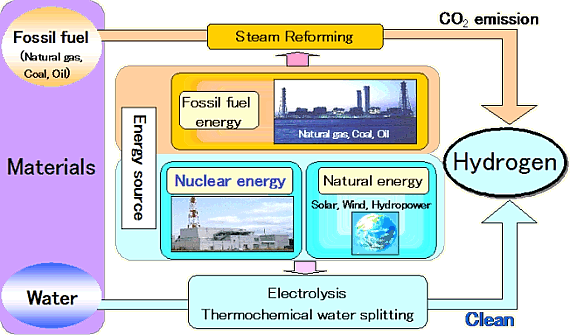Hydrogen must be artificially produced from raw materials and energy, since hydrogen exists scarcely in the nature. The conventional hydrogen production process in industry is mainly the steam reforming of methane (natural gas), in which a large amount of carbon dioxide (CO2) emission is inevitable by any means unless proper carbon management is taken.
On the other hand, hydrogen production without significant emission of CO2 is possible by water electrolysis or thermochemical water splitting using natural energy (renewable energy) or nuclear energy. However the cost of electrolysis production is thought to be not so inexpensive because of rather high electricity cost at least in Japan and relatively low thermal efficiency. A thermochemical water splitting method by using high temperature heat from HTGR is recognized to have a high potential to produce hydrogen with high economy and high efficiency.
In order to meet a large demand of hydrogen at the matured stage beyond 2020, technologies of HTGR hydrogen and coal reforming hydrogen shall be developed. The Japan Atomic Energy Agency (JAEA) is going forward with the project using the High-Temperature Engineering Test Reactor (HTTR) to establish HTGR technology and heat utilization technology which consists of hydrogen production technology and gas turbine technology including commercial HTGR plant design, looking ahead in a hydrogen economy.

Methods of Hydrogen Production
FAQ
- What is HTGR ?
- Structure of HTGRs
- Temperature Ranges Applicable to Various Industrial Fields
- Development Status of HTGRs in the World
- Outline of High Temperature Engineering Test Reactor
- Establishment of technical bases of high temperature gas-cooled reactor with the HTTR
- Various Hydrogen Production Methods
- R&D on Thermochemical IS Process
- Hydrogen Society in the Future